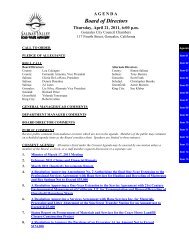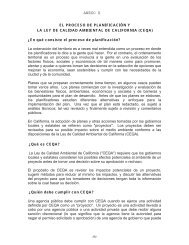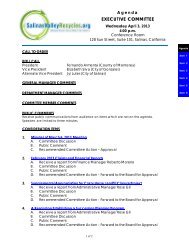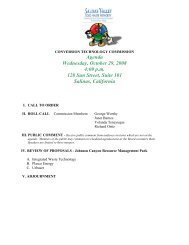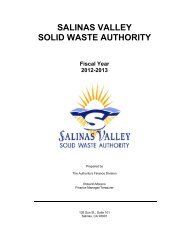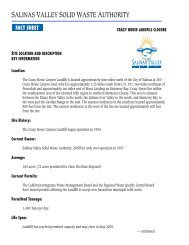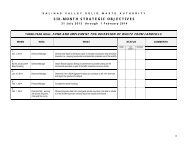revised final closure plan - Salinas Valley Solid Waste Authority
revised final closure plan - Salinas Valley Solid Waste Authority
revised final closure plan - Salinas Valley Solid Waste Authority
You also want an ePaper? Increase the reach of your titles
YUMPU automatically turns print PDFs into web optimized ePapers that Google loves.
Revised Final Closure Plan July 2010<br />
Crazy Horse Sanitary Landfill -15- 103-97133<br />
from the site.” The 1993 analysis estimated seismically induced permanent displacement in the base<br />
liner and LCRS “on the order of less than one-half of one foot.”<br />
In 2004 (Emcon/OWT, Inc. 2004b) both veneer (<strong>final</strong> cover) and global (through refuse mass) slope<br />
stability analyses were performed to evaluate the affects of the vertical expansion of the landfill to the<br />
<strong>final</strong> maximum elevation of 635 feet amsl. This analysis is attached to the RFCP in Appendix C. For<br />
the slope stability analysis performed in the 2004 study, the design ground motion was chosen as that<br />
having a 10 percent probability of exceedance in 50 years 2 and calculated at 0.53 g. This design<br />
ground motion is more stringent than the ground motion associated with the MCE estimated in the<br />
1993 analysis. The 2004 slope stability analysis concluded the following regarding global and veneer<br />
stability for the proposed site conditions analyzed in 2004:<br />
• For the proposed <strong>final</strong> landfill slopes, the static factor of safety for global<br />
stability is equal to or greater than 1.5, the generally accepted value for static<br />
factor of safety.<br />
• For the proposed <strong>final</strong> landfill slopes, a displacement analysis concluded the<br />
permanent displacement was less than 1 foot for global stability supportive of the<br />
findings in the initial 1993 analysis.<br />
• For the proposed <strong>final</strong> cover on 3H:1V slopes, a veneer stability analysis for a<br />
soil vegetative layer determined the seismically induced permanent displacement<br />
would be less than 1 foot if the interface shear strengths within the <strong>final</strong> cover<br />
system equaled or exceeded a shear strength envelope defined by a friction angle<br />
of 31 degrees. This friction angle would also provide a static factor of safety<br />
greater than the required 1.5 value.<br />
However, these previous analyses did not consider the existence of localized slopes steeper than<br />
3H:1V at the crest of the landfill. Overall global stability of the landfill is not affected by these slope<br />
conditions as the previous critical surfaces were determined to be over the lined areas on the west side<br />
of the topdeck. Sideslopes along the lined area will all be 3H:1V or less, therefore the stability<br />
assumptions, conditions, and findings of those previous studies over the critical surfaces on the lined<br />
area remain unchanged. Both the 1993 and 2004 global stability analyses concluded the existing base<br />
liner and LCRS at the CHLF would experience seismically induced permanent displacement of less<br />
than the generally accepted limit of 12 inches.<br />
2.13.1.2 Existing Steep Slopes<br />
The CHLF will possess a few localized areas of over steepened slope during the post<strong>closure</strong> period.<br />
In 2009, Golder performed additional veneer stability calculations regarding these slopes which range<br />
from 2.3H:1V to 2.2H:1V. Slope measurements on the <strong>final</strong> slopes are shown on Figure C-1<br />
(Appendix C). The upper slope above a 12-foot wide bench on the eastern face of the topdeck (facing<br />
the entrance facilities) currently has an average slope of 2.2H:1V in steepness over an approximate<br />
area of 1.0 acres, with a localized area approaching 2H:1V. The slope height of the over steepened<br />
section is approximately 24 feet. The SVSWA directed its site operator to stop this steep slope<br />
construction and return to typical 3H:1V sideslopes above the steepen area in anticipation of site<br />
<strong>closure</strong>. The 3H:1V slope segment will be approximately 10 feet in height at <strong>final</strong> <strong>closure</strong>. Below<br />
2 per the United States Geological Survey (USGS) Probabilistic Seismic Hazard Assessment.<br />
Golder Associates



